An Organic ROW Restoration Project
(cover article published in UA Newsline Magazine, Jan/Feb 2017)
Drag to resize
Our vegetation management practices have evolved from cutting most ROW vegetation by hand, to applying herbicides to unwanted vegetation, to creating the Integrated Vegetation Management (IVM) framework. To handle developing philosophies and the addition of new information and techniques, Best Management Practices were born. The current edition of IVM Best Management Practices describes four main methods of vegetation control: Mechanical, Chemical, Cultural, and Biological. Though these methods are outlined separately, an integrated application of combined methods takes place in the field.
With the help of BMPs, our industry does a good job of advocating for the appropriate use of each method. For example, the IVM BMPs for chemical applications describe techniques in great detail in order to guide practitioners toward responsible use of herbicides—namely, promoting a move to low and ultra-low volume techniques with a goal to reduce the herbicide use per acre.
Over the years, various Cultural and Biological IVM methods were researched, developed, and promoted. While proving effective, these methods might not always be the least expensive solution or show instant results, making it difficult for them to gain popularity. However, today’s increasingly eco-friendly society is overcoming those drawbacks by showing the value of Cultural and Biological IVM methods, as these methods have a tendency to work with (and not against) Nature’s ecology. One benefit is that they can respond to the changing environmental regulations on public and private land. Several countries in Europe have limited or banned the use of glyphosate in public areas. In the U.S., the entire Chesapeake Bay has enacted a production ban limiting the contaminants present in its watershed (site reference: http://www.chesapeakebay.net/issues/issue/chemical_contaminants) Everywhere, permit requirements are becoming more stringent, spray-free zones are being created, and sustainable practices are the new expectation. As we continue to expand our BMPs, it would be good to take these changes into consideration.
In that light, an organic restoration project near Spotsylvania, VA was executed following a pipeline construction project. The restoration technique used is called organic hydroseeding. Organic hydroseeding has been done successfully in other industries, such as landscaping and non-conventional agriculture, and now within our industry. This seeding method takes into consideration that which plants need to thrive: soil microorganisms, organic matter, water, and oxygen. Microorganisms live off organic matter and plant root exudates, and excrete nutrients that plants absorb and depend on for their growth. Organic matter not only provides food for microorganisms, and therefore food for plants, but also adds to the soil structure, creating oxygen pockets and acting like a sponge to take up and store water.
The key ingredients for this process are: a proper seed mix, mycorrhizae, slow-release organic fertilizer, organic matter, and wood fiber mulch treated with non-toxic dye. While they are simple elements, each is essential. For example, the advantage of releasing nitrogen slowly from the organic fertilizer is to avoid the conventional “spike and drought” of nitrogen into the soil; it also provides a consistent feed to the plants as they need it. Organic matter contains many living and breathing soil microorganisms that are beneficial because they actively create favorable growing conditions. Even the wood fiber mulch is an important contributor: it acts as a binder to help capture and retain moisture, and it provides a future food source. For truly organic hydroseeding, using a vegetable oil-based dye keeps the soil microbiology healthy. In order to implement this project, new specifications had to be written, as well as training for the contractors.
In the clean, live method of organic hydroseeding, attention to equipment is important. The use of baking soda to thoroughly rinse the equipment inhibits unwelcome tag-alongs in your live seed mix. Also opt for clean pond, well, or creek water when it is readily available—it is a natural resource and already has beneficial microbes in it. Where there is only access to city water, neutralize chloride with the help of vitamin C, or with a liquid humate, since chloride negatively impacts soil microbiology.”
Organic hydroseeding slurries take best on disked and slightly damp soils, followed by a light rain sprinkle the day after application. Make sure to spread the slurry as evenly as possible. All ingredients used are organic, pass environmental regulations and can be applied directly on creek, streams, and river banks.
After the April 2016 treatment, two weeks of drought were followed by two weeks of intensive rain. Despite the severe weather conditions, results were equal to or better than conventional methods used.
There was little to no runoff, and additional spot treatments were unnecessary. After seven weeks, a consistent ground cover was established; five months later the ROW was blossoming.
Proper attention should also be given to the seed mix. Rather than accepting seeding species that are known to cover grounds quickly (such as clover and annual ryes) to meet erosion control permit regulations, strategically select for what you want to see blossom in the long run. Mix annuals with natives, perennials, and long term compatible ROW species. Attention to detail, such as incorporating mycorrhizae and using chloride-free water, will allow the seeds to germinate faster and grow better.
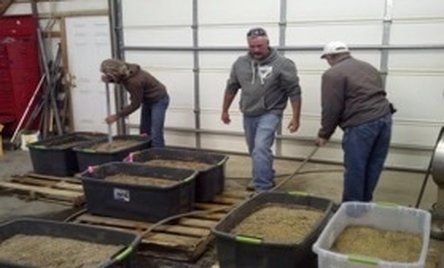
A crew mixes the seeds with mycorrhizae prior to soaking them overnight in chloride-free water.
In the clean, live method of organic hydroseeding, attention to equipment is important. The use of baking soda to thoroughly rinse the equipment inhibits unwelcome tag-alongs in your live seed mix. Also opt for clean pond, well, or creek water when it is readily available—it is a natural resource and already has beneficial microbes in it. Where there is only access to city water, neutralize chloride with the help of vitamin C, or with a liquid humate, since chloride negatively impacts soil microbiology.”
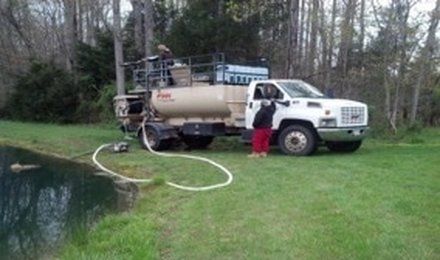
A crew fills the hydroseeding tank with pond water to make a slurry.
Organic hydroseeding slurries take best on disked and slightly damp soils, followed by a light rain sprinkle the day after application. Make sure to spread the slurry as evenly as possible. All ingredients used are organic, pass environmental regulations and can be applied directly on creek, streams, and river banks.
After the April 2016 treatment, two weeks of drought were followed by two weeks of intensive rain. Despite the severe weather conditions, results were equal to or better than conventional methods used.
There was little to no runoff, and additional spot treatments were unnecessary. After seven weeks, a consistent ground cover was established; five months later the ROW was blossoming.
There was little to no runoff, and additional spot treatments were unnecessary. After seven weeks, a consistent ground cover was established; five months later the ROW was blossoming.
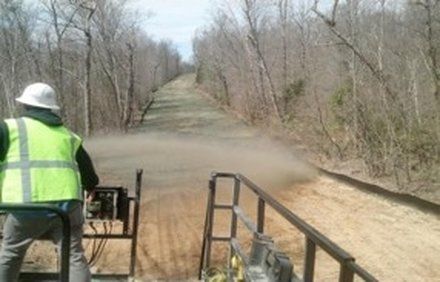
A crew member sprays the slurry from the top of a hydroseeder truck.
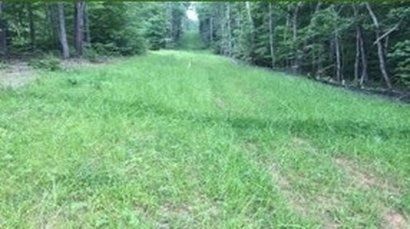
The treated ROW, seven weeks after hydroseeding.
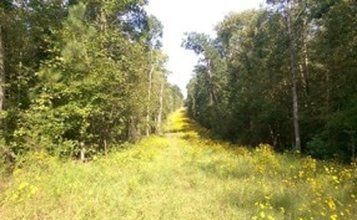
The treated ROW, five months after hydroseeding.
The project costs involved were in alignment with costs for conventional methods. In addition, due to the quality of the ingredients, results came about more quickly than usual. Although this particular project and its results are relatively recent, plans are already in the making to use this technique on a larger scale.
As with any new method, integrating organic hydroseeding is easiest when streamlined into your existing work schedule. For example, best results can be expected when a treatment is applied to bare soil, making it ideal for re-seeding a ROW immediately after capital work is complete. This method is also excellent to quickly rebuild compatible vegetation in an area affected by fire. Where there is no planned work but a vegetation conversion is desired, ROW soil can be disked or tilled prior to organic hydroseeding. This can be done to reclaimed ROWs, areas affected by erosion; or bare creeks, streams, and river banks needing a well-established vegetation root mass. By incorporating organic hydroseeding and other eco-logical alternative practices, we give the natural world our best effort.
With the public’s increased environmental awareness, this and other Cultural and Biological Methods of IVM applied in a sustainable way might play an increasingly important role in upcoming ROW care. The variety of Cultural and Biological methods we could apply within our industry are truly endless; a simple brainstorm session with an out-of-the-box mentality will demonstrate this. Industries other than our own, yet also concerned with vegetation management, are already implementing a variety of alternative methods with great success. Our IVM provides a framework to ensure we don’t just keep doing the same thing over and over. Just as we moved from mechanical to chemical maintenance, we should continue to push for the development of more BMPs.
To request additional information regarding organic hydroseeding and other Cultural and Biological IVM methods, visit GrowWithTrees.com or email branchout@growwithtrees.com.


